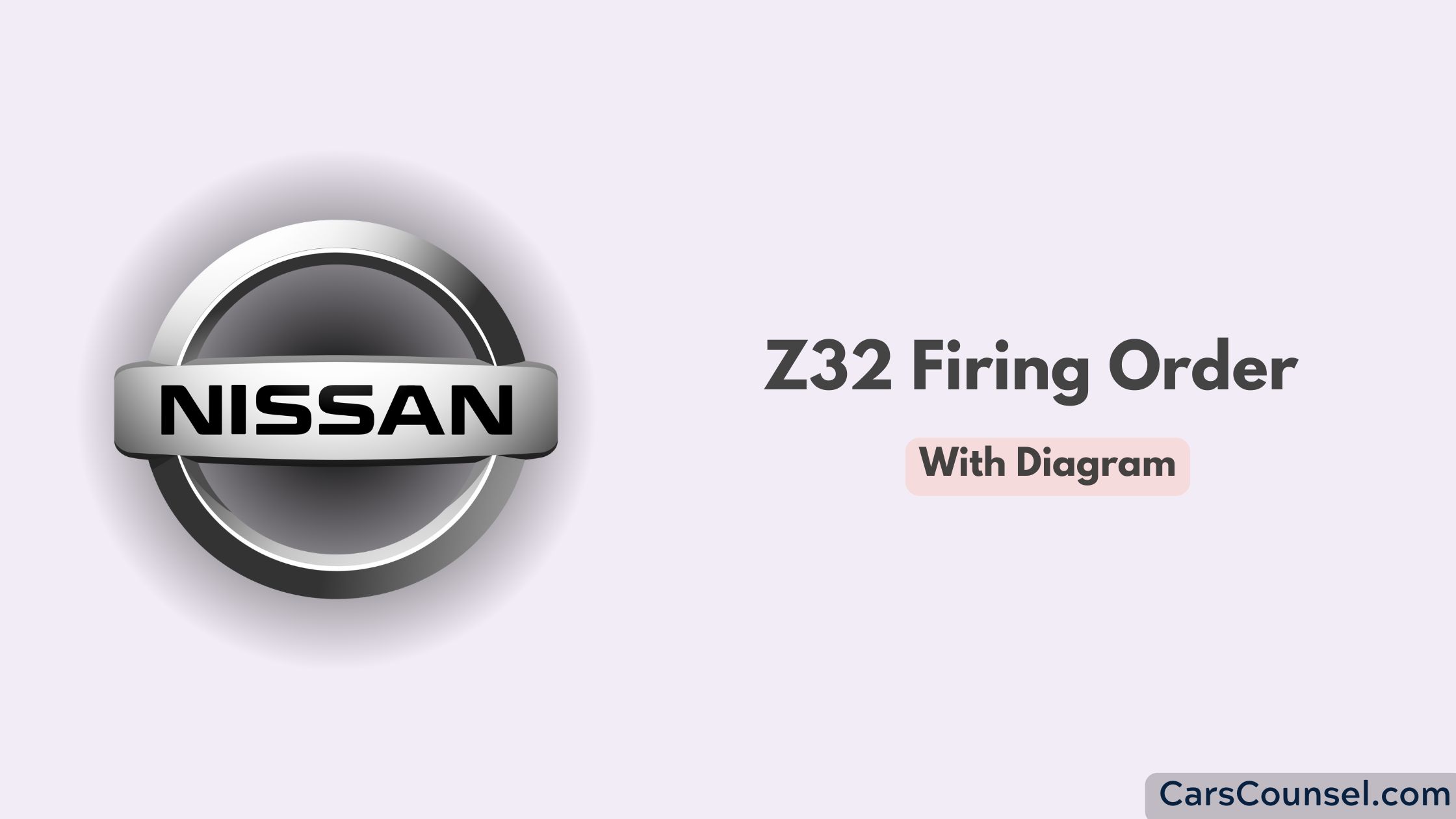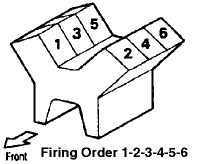The Nissan Z32, powered by the VG30DE or VG30DETT engine, is an iconic sports car engine platform. Found in the 1990s Nissan 300ZX, these engines delivered reliable performance and were revered for their power and balance.
A crucial aspect of the VG30 engine’s functionality is the firing order, the sequence in which the cylinders fire to create smooth and efficient power.
In this guide, we’ll explore the Z32’s firing order, why it matters, and how to maintain and troubleshoot it. Whether you’re a 300ZX owner, a mechanic, or an enthusiast looking to optimize performance, this article provides everything you need to know.

Quick Navigation
The Z32 Firing Order
The firing order for the Nissan Z32 VG30DE and VG30DETT engines is: 1-2-3-4-5-6

How the Firing Order Works
- Cylinder 1 Fires First: Located on Bank 1, closest to the front of the engine.
- Cylinder 2 Fires Second: Positioned on Bank 2, closest to the front.
- Cylinder 3 Fires Third: The middle cylinder on Bank 1 ignites.
- Cylinder 4 Fires Fourth: The middle cylinder on Bank 2 fires next.
- Cylinder 5 Fires Fifth: The rear cylinder on Bank 1 fires.
- Cylinder 6 Fires Sixth: The rear cylinder on Bank 2 completes the sequence.
This sequence alternates firing events between the two banks of cylinders to ensure smooth operation and consistent power delivery.
Why Nissan Uses the 1-2-3-4-5-6 Firing Order
The 1-2-3-4-5-6 firing order is optimized for the VG30DE/DETT’s V6 design for the following reasons:
- Balance: Alternating ignition events across the banks reduces vibrations and improves stability.
- Crankshaft Design: Matches the crankshaft’s throw arrangement, minimizing stress on moving parts.
- Heat Management: Evenly distributes combustion heat across all six cylinders to prevent overheating.
- Efficient Torque Delivery: Ensures consistent power strokes for smooth operation and steady acceleration.
What Is a Firing Order?
The firing order refers to the sequence in which an engine’s cylinders ignite their air-fuel mixture. Each cylinder fires in a controlled rhythm to generate power, drive the pistons, and rotate the crankshaft. In a V6 engine like the VG30DE/DETT, the firing order is essential for ensuring balance, efficiency, and power delivery.
Why the Firing Order Matters
- Smooth Operation: Reduces vibrations and ensures balanced power output.
- Efficiency: Optimized combustion improves fuel economy and reduces emissions.
- Durability: Distributes stress evenly across the crankshaft and other components.
- Performance: Consistent firing ensures steady torque and responsive acceleration.
Overview of the Nissan Z32 Engine
The Z32’s VG30DE and VG30DETT engines are 3.0-liter V6 configurations, with the latter being twin-turbocharged. These engines are celebrated for their advanced design and smooth operation, making them the centerpiece of the 300ZX’s performance.
Key Features of the Z32 Engine
- V6 Configuration: Six cylinders arranged in a 60-degree “V” layout.
- Twin Cam Design: Dual overhead camshafts (DOHC) control the intake and exhaust valves.
- Turbocharged Option: The VG30DETT features twin turbochargers for increased power.
- Cylinder Numbering:
- Bank 1: Cylinders 1, 3, 5 (driver’s side in U.S. models).
- Bank 2: Cylinders 2, 4, 6 (passenger’s side in U.S. models).
Identifying the Firing Order
To verify the firing order, you need to understand the cylinder numbering and the ignition system setup.
Cylinder Numbering
The cylinders are numbered from front to rear:
- Bank 1 (Driver’s Side): Cylinders 1, 3, 5.
- Bank 2 (Passenger’s Side): Cylinders 2, 4, 6.
Ignition System
The VG30DE and VG30DETT engines use an electronic ignition system. The engine control unit (ECU) manages spark delivery, ensuring that the correct cylinder fires at the right time.
Symptoms of an Incorrect Firing Order
An incorrect firing order can lead to significant engine performance issues. Recognizing these symptoms can help you identify and fix problems early.
Common Symptoms
- Engine Misfires: Uneven power delivery due to cylinders firing out of sequence.
- Rough Idling: Excessive vibrations or instability when the engine is idling.
- Power Loss: Reduced acceleration and overall performance.
- Backfiring: Combustion occurring in the intake or exhaust system due to improper timing.
- Increased Fuel Consumption: Inefficient combustion results in higher fuel usage and emissions.
Diagnosing and Fixing Firing Order Problems
If you suspect issues with the firing order in your Z32 engine, follow these steps to diagnose and resolve them:
Diagnostic Steps
- Inspect Ignition Coils: Check each ignition coil for proper operation and alignment with the firing order.
- Verify ECU Programming: Use a diagnostic tool to ensure the ECU is programmed correctly for the firing sequence.
- Check Spark Plug Wires: Ensure each wire is connected to the correct cylinder in the 1-2-3-4-5-6 sequence.
- Perform a Compression Test: Confirm that all cylinders have adequate compression to support combustion.
Fixing Common Issues
- Reconnect Spark Plug Wires: Route the wires correctly based on the cylinder numbering and firing order.
- Replace Faulty Ignition Components: Install new spark plugs, ignition coils, or wires if they show signs of wear or damage.
- Update the ECU: If software issues are causing misfires, reflash or update the ECU.
- Adjust Timing: Realign the timing components, such as the crankshaft and camshaft, to ensure proper synchronization.
Preventative Maintenance for Firing Order Reliability
Maintaining the correct firing order is crucial for the performance and longevity of your Z32 engine. Here are some preventative tips:
Regular Inspections
- Check spark plugs, ignition coils, and wiring for wear or damage.
- Inspect the ECU and associated wiring for any faults or irregularities.
Replace Components as Needed
- Replace spark plugs and ignition coils at manufacturer-recommended intervals.
- Use high-quality OEM or aftermarket parts to ensure compatibility and reliability.
Monitor Engine Performance
- Pay attention to signs of misfires, rough idling, or power loss.
- Use an OBD-II scanner to check for error codes that might indicate firing order issues.
FAQs About the Z32 Firing Order
Can I Change the Firing Order?
No, the firing order is determined by the engine’s design and crankshaft configuration. Altering it would require significant mechanical modifications.
What Happens If the Firing Order Is Incorrect?
An incorrect firing order can lead to misfires, backfiring, power loss, and potential damage to engine components.
How Can I Verify the Firing Order?
Refer to the service manual, inspect ignition coil connections, and use diagnostic tools to confirm the firing sequence.
Is the Firing Order the Same for All V6 Engines?
No, firing orders vary based on the engine manufacturer and design. However, many V6 engines share similar firing sequences due to their balanced design.
Engines with Similar Firing Orders
- 2001 Nissan Altima Firing Order
- 2002 Nissan Altima Firing Order
- 2008 Nissan Titan Firing Order
- 2006 Nissan Titan Firing Order
- 2005 Nissan Titan Firing Order
Conclusion
The 1-2-3-4-5-6 firing order is a critical component of the Nissan Z32’s VG30DE and VG30DETT engines, ensuring smooth operation, balanced power delivery, and efficient combustion. Understanding this sequence is essential for maintaining and troubleshooting your engine, whether it’s stock or modified.
By following proper maintenance practices, addressing issues promptly, and using high-quality components, you can keep your Z32 engine running at peak performance. Whether you’re a DIY enthusiast or a seasoned mechanic, mastering the firing order is a key step in caring for this legendary V6 powerplant.

